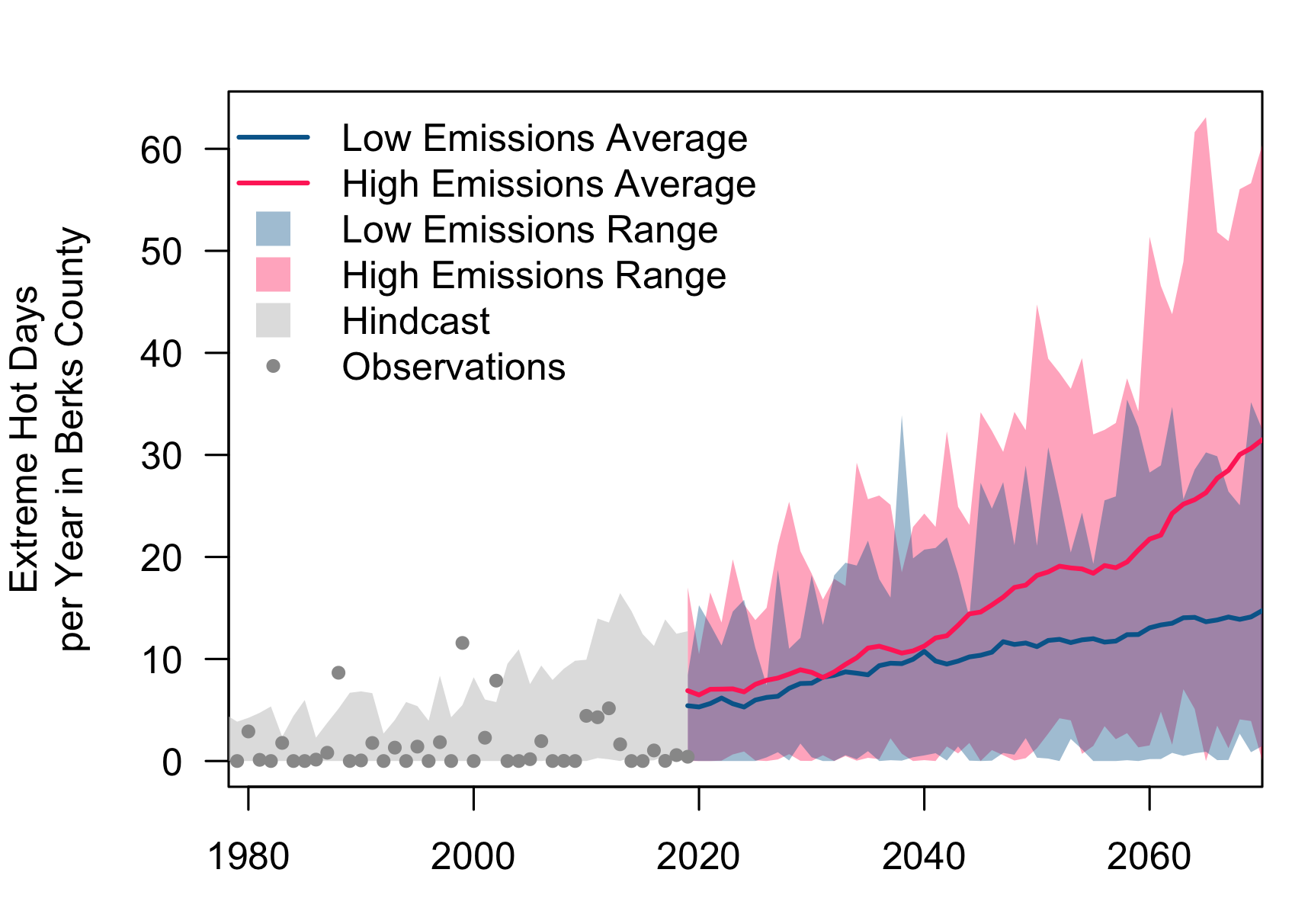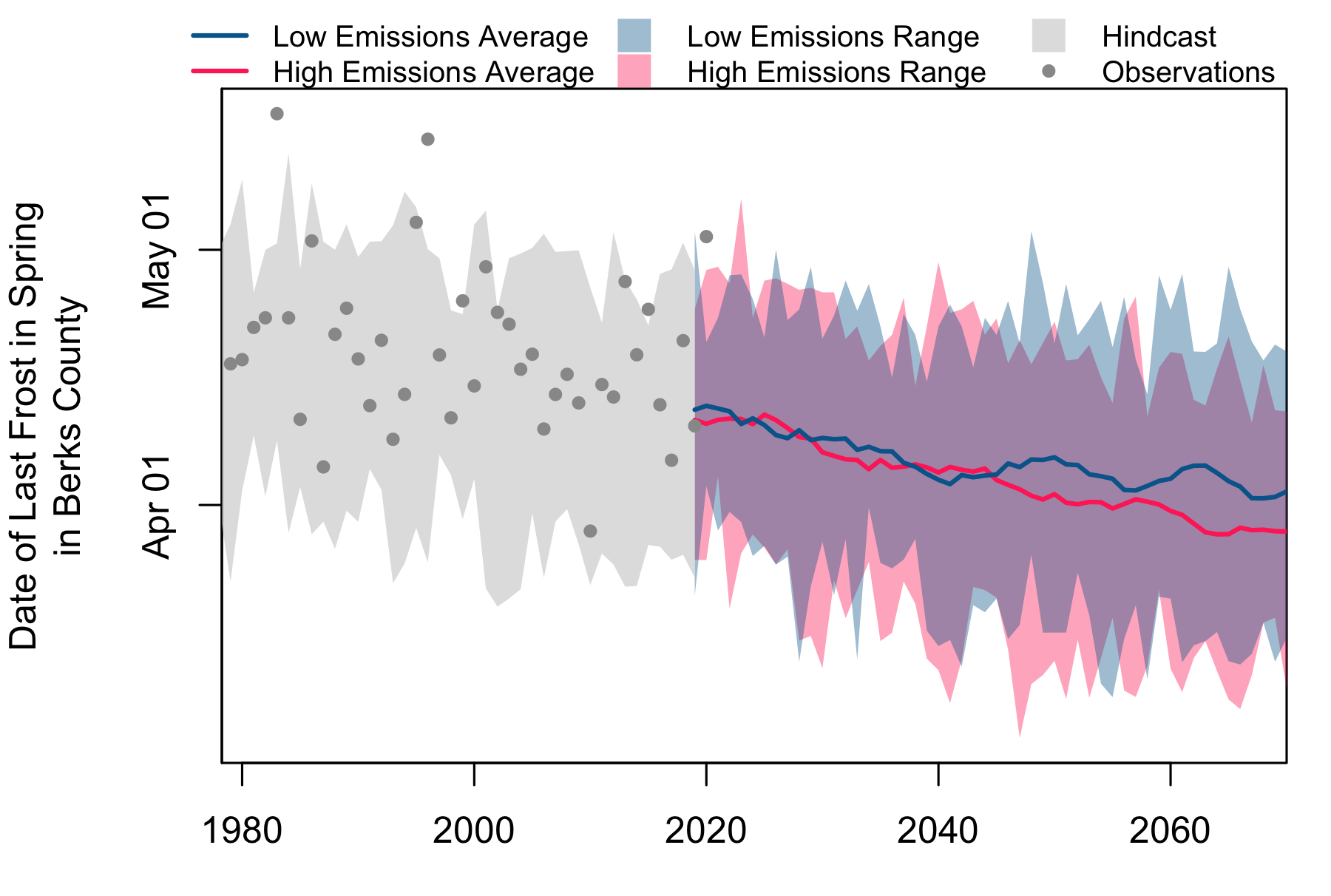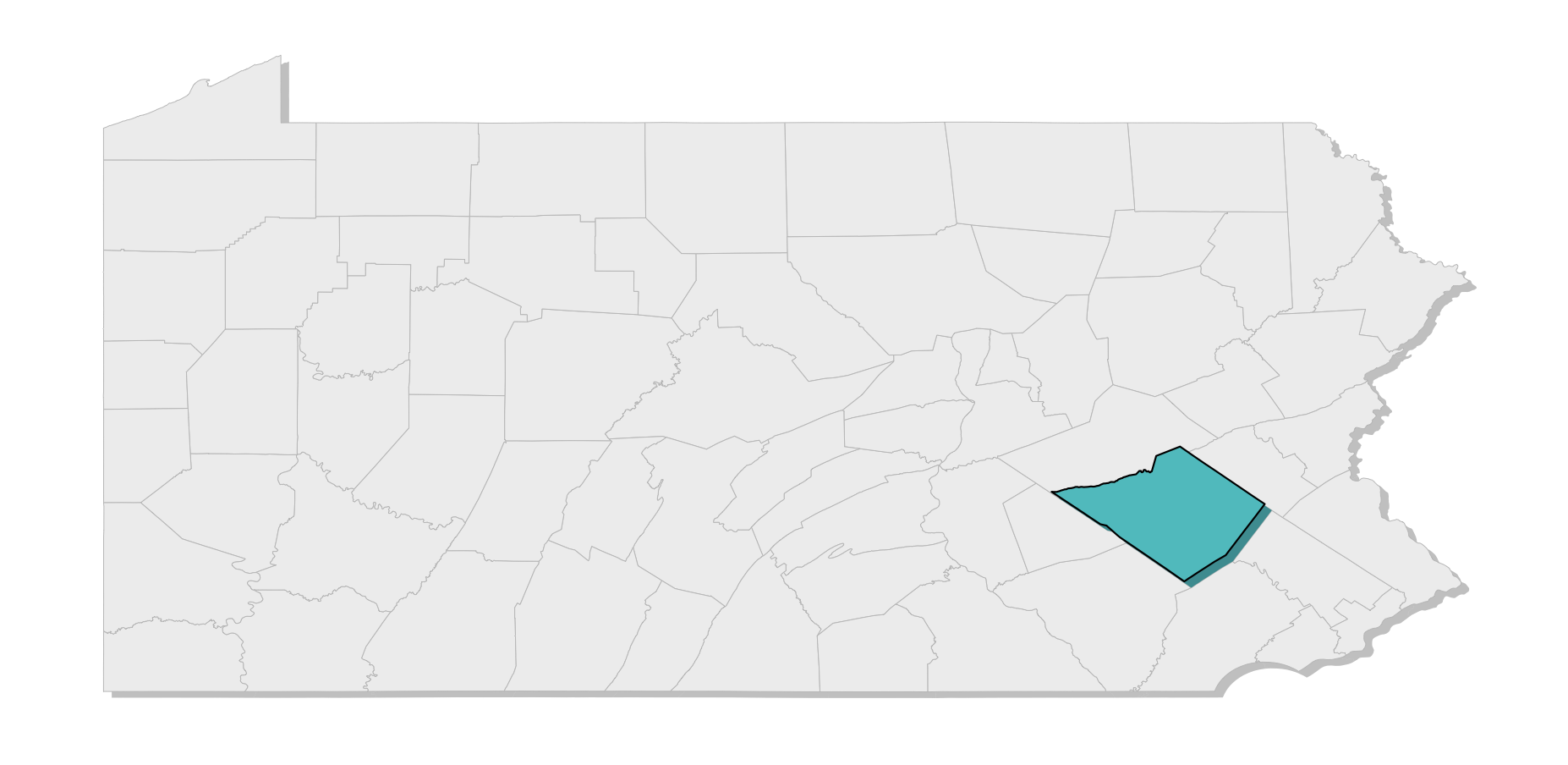Berks County, PA
Berks County residents will face increasingly severe weather-related hazards, such as heat waves, flooding, and shifting seasons.
As the frequency and intensity of local hazards change, it is important for all of us to protect communities and local habitats. Using the best data, scientists can project how long-term averages in daily weather will change in the future, and the effects this will have on localities.
Information on extreme weather and hazards can empower citizens, decision-makers, and other stakeholders to make infored risk-reduction decisions. With planning and preparation, Berks County can reduce risks for all residents.

Changing Temperature Patterns
Human health, stream and river health, and infrastructure are all threatened by higher temperatures. At 95°F, it is hard to keep indoor areas and our bodies cool. Berks County’s summers are getting hotter. On average, Berks County sees 2 days per year in excess of 95°F. Within the next 50 years (by 2070), Berks County can expect a yearly average of 15 to 31 days above 95°F, with associated increases in cooling costs, reduced air quality, and heat-related illnesses.
![]() HEAT-RELATED ILLNESSES: Heatwaves can kill people and pets. In Pennsylvania, more than 80 people have died from extreme heat between 2010 and 2019. Individuals at higher risk include children, pregnant women, older adults, outdoor workers, and lower-income residents.
HEAT-RELATED ILLNESSES: Heatwaves can kill people and pets. In Pennsylvania, more than 80 people have died from extreme heat between 2010 and 2019. Individuals at higher risk include children, pregnant women, older adults, outdoor workers, and lower-income residents.
![]() REDUCED STREAM HEALTH: Across the Mid-Atlantic, stream temperatures increased roughly 2.5 degrees F from 1960 to 2010. Warmer water reduces habitat for cold-water fish and supports blue-green algae growth and waterborne illnesses in lakes and streams, disrupting recreational activities like swimming and fishing.
REDUCED STREAM HEALTH: Across the Mid-Atlantic, stream temperatures increased roughly 2.5 degrees F from 1960 to 2010. Warmer water reduces habitat for cold-water fish and supports blue-green algae growth and waterborne illnesses in lakes and streams, disrupting recreational activities like swimming and fishing.

The graph shows the number of days in a year with temperatures above or equal to 95°F. Dots represent observed annual days of extreme temperatures and the gray shading shows the hindcast1. Two scenarios of the future are shown as a high-emissions scenario (RCP 8.5) in red and a low-emissions scenario (RCP 4.5) in blue. Data for the future scenarios are retrieved from Multivariate Adaptive Constructed Analogs (MACA), and observed data are from the Gridded Surface Meteorological Dataset (gridMET).
Changing Rainfall Patterns
Heavy rainfall in Berks County is increasing in frequency and intensity, causing flash floods, landslides, property damage, septic backups, well contamination, mold and indoor air quality issues, and impacts to water quality in local streams and rivers. Annual rainfall in Berks County will likely increase by an average of 2 to 3 inches (2050-2079 average compared to the 1990-2019 average).
![]() REDUCED HUMAN HEALTH: Rising water tables cause septic backups and groundwater pollution, putting drinking water at risk of contamination. Changing moisture levels impact the spread of mold and illness, including tick- and mosquito-borne diseases as high humidity promote their activity.
REDUCED HUMAN HEALTH: Rising water tables cause septic backups and groundwater pollution, putting drinking water at risk of contamination. Changing moisture levels impact the spread of mold and illness, including tick- and mosquito-borne diseases as high humidity promote their activity.
![]() FLOODING: Heavy rain overwhelms infrastructure and drainage systems, causing property damage and covering roads. Runoff from mountains and hills can lead to flash flooding of rivers and streams.
FLOODING: Heavy rain overwhelms infrastructure and drainage systems, causing property damage and covering roads. Runoff from mountains and hills can lead to flash flooding of rivers and streams.

The graph shows the change in annual rainfall compared to the average between 1990 and 2019. The gray lines show the hindcast. Two scenarios of the future are shown as a high-emissions scenario (RCP 8.5) in red and a low-emissions scenario (RCP 4.5) in blue. Data for the future scenarios are retrieved from MACA.
Shifting Seasons
Seasons are changing in length and timing in Berks County with an earlier spring, delay of fall, and shorter winter. While a longer frost-free period can benefit some crops or allow for double cropping, it can limit plant diversity, encourage invasive species, and threaten human and ecosystem health. Within the next 50 years (by 2070), the frost-free period will average 5 to 7 weeks longer in Berks County.
![]() REDUCED HUMAN HEALTH: Milder winters help more ticks and mosquitos survive the winter and earlier springs make their biting season longer. Earlier springs also cause trees and flowers to bloom earlier leading to a longer allergy season.
REDUCED HUMAN HEALTH: Milder winters help more ticks and mosquitos survive the winter and earlier springs make their biting season longer. Earlier springs also cause trees and flowers to bloom earlier leading to a longer allergy season.
![]() EXPOSED CROPS: During a false spring, warm weather in late winter or early spring causes crops and plants to grow too early leaving them exposed to frost. Reduced snow cover from warm winters and longer summers increases the risk of drought. Crops will become more vulnerable to pests and invasive species as warmer weather also helps them grow and survive.
EXPOSED CROPS: During a false spring, warm weather in late winter or early spring causes crops and plants to grow too early leaving them exposed to frost. Reduced snow cover from warm winters and longer summers increases the risk of drought. Crops will become more vulnerable to pests and invasive species as warmer weather also helps them grow and survive.

The graph shows the date of the last frost (less than or equal to 32°F) in spring. Dots represent observed dates of the last frost in spring and the gray shading shows the hindcast. Two scenarios of the future are shown as a high-emissions scenario (RCP 8.5) in red and a low-emissions scenario (RCP 4.5) in blue. Data for the future scenarios are retrieved from Multivariate Adaptive Constructed Analogs (MACA), and observed data are from the Gridded Surface Meteorological Dataset (gridMET).
Development of the Local Hazard Outlooks was supported by the National Oceanic and Atmospheric Administration (NOAA) grants NA18OAR4310302 and NA21OAR4310310.
v2.0-beta1 2025-06-04
Footnotes
Hindcasts are model results for a historical period. Hindcasts are useful for comparing observations with model estimates.↩︎
